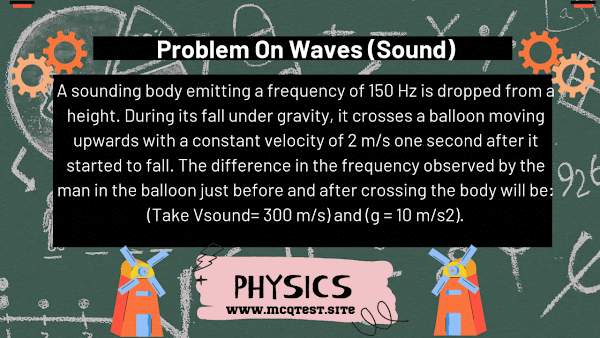Q1: A sounding body emitting a frequency of 150 Hz is dropped from a height. During its fall under gravity, it crosses a balloon moving upwards with a constant velocity of 2 m/s one second after it started to fall. The difference in the frequency observed by the man in the balloon just before and after crossing the body will be: (Take \( v_{\text{sound}} = 300 \, \text{m/s} \) and \( g = 10 \, \text{m/s}^2 \)).
Solution:
- Step 1: Calculate the velocity of the falling body after 1 second:
\[ v_{\text{body}} = u + g t = 0 + 10 \times 1 = 10 \, \text{m/s}. \]
- Step 2: Apparent frequency before crossing:
The Doppler effect formula is: \[ f_{\text{apparent}} = f \frac{v_{\text{sound}} + v_{\text{observer}}}{v_{\text{sound}} - v_{\text{source}}}. \] Here, \( v_{\text{observer}} = -2 \, \text{m/s} \) and \( v_{\text{source}} = 10 \, \text{m/s} \). \[ f_{\text{before}} = 150 \frac{300 + 2}{300 - 10} = 150 \frac{302}{290} \approx 156.21 \, \text{Hz}. \]
- Step 3: Apparent frequency after crossing:
Now, \( v_{\text{observer}} = 2 \, \text{m/s} \) (balloon moving toward source). \[ f_{\text{after}} = 150 \frac{300 - 2}{300 + 10} = 150 \frac{298}{310} \approx 144.20 \, \text{Hz}. \]
- Step 4: Difference in observed frequencies:
\[ \Delta f = f_{\text{after}} - f_{\text{before}} = 156.21 - 144.20 = 12.01 \, \text{Hz}. \]
Final Answer: The difference in frequencies is: \[ \boxed{12.01 \, \text{Hz}} \]




.png)



0 Comments